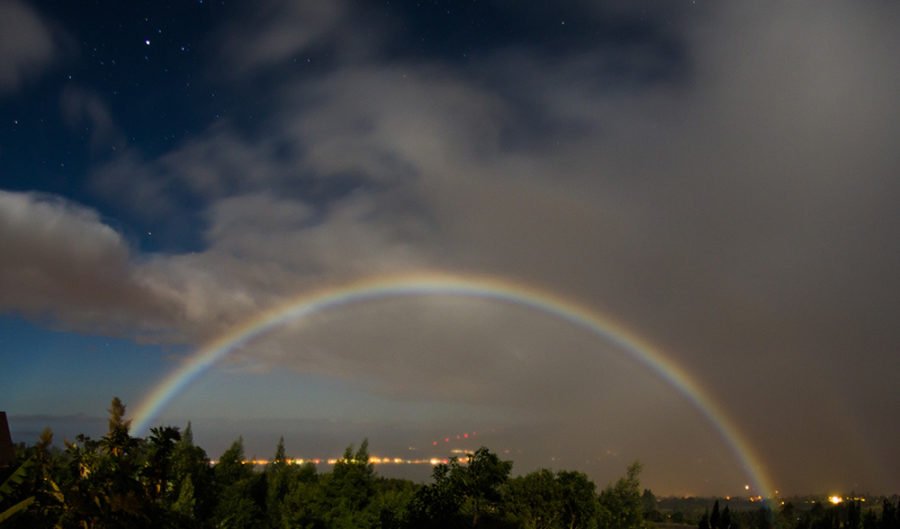Rainbows and moonbows

WHO WOULD HAVE thought that sunlight passing through a cloud of simple water droplets would produce such an extraordinarily beautiful effect? We take colourful rainbows completely for granted, but we always take a second look whenever one appears.
It was the French philosopher and mathematician René Descartes who, in the early 17th century, worked out how sunlight and raindrops combine to generate an arc of colour. Light entering each droplet is bent through an angle of 138°, almost doubling back on itself through a combination of refraction and reflection.
But the light is also split into a spectrum of colours. With each of the millions of droplets in a rain shower bending and dispersing the light through an identical angle, the net effect to an observer is an arc of colour with a radius of 42° on the side of the sky opposite the Sun. Yes, you’ve guessed it – the 42° arc of the rainbow is the difference between 180° (which would mean the light exactly doubling back on itself ) and 138°, the actual angle of bending.

An Earthling rainbow has a radius of 42° and will appear on the side of the sky opposite the Sun. (Image: Un-Alien-Able / Flickr)
It’s not just sunlight that produces rainbows. Next time the Moon is full and relatively low in the sky, take a quick look in the opposite direction. If there are rain showers around, you might be lucky enough to see a rare lunar rainbow. Because moonlight is much fainter than sunlight, the colours are harder to see, but they are there, and can be photographed with a modern digital camera. You will need a tripod and an exposure time of up to a minute or so – and a little practice.
Do rainbows occur on other worlds?
Yes, when there is precipitable moisture in an atmosphere, there will be rainbows. But the moisture needn’t be water. Take Saturn’s moon Titan, for example. This world has a rockhard surface of ice at a temperature of –180°C. Its misty atmosphere is mostly nitrogen, but also has droplets of liquid natural gas in it, a mixture of methane and ethane.
These produce a rain cycle similar to that of Earth’s, generating rivers, lakes and seas of liquid hydrocarbons. And yes – rainbows, when sunlight penetrates the clouds.
Titan’s rainbows are bigger than Earth’s, with radii of 49° due to the differing refractive properties of these liquids. And the colours are somewhat washed out, thanks to the pervasive orange colour of Titan’s smoggy atmosphere.
Fred Watson is a regular AG columnist, award-winning science communicator and the astronomer-in-charge at the Australian Astronomical Observatory.
This article originally appeared in the Jul-Aug 2014 issue of Australian Geographic (AG#121).
READ MORE:




